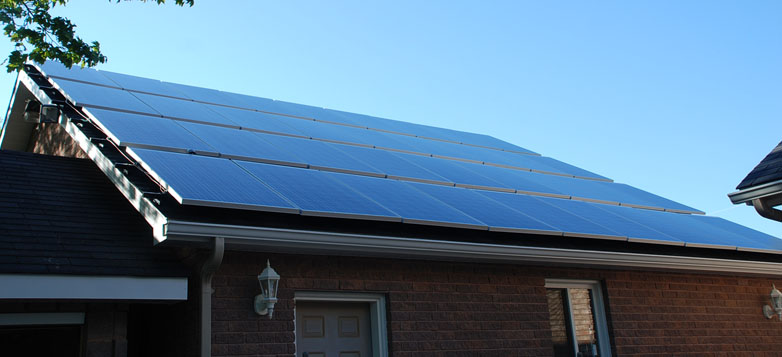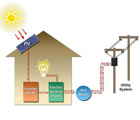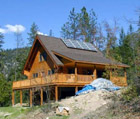

Typical price for a DIY small 12V off grid cottage
Most panels intended for grid tied systems have 72 cells or 60 cells. The size of 60 cell panels varies one or 2% by manufacturer. 72 cell panels are larger as a group. Off grid only panels intended for 12V systems have fewer cells, typically 30 cells and are smaller and are much more expensive in terms of $ per Watt.
This example uses 60 cell panels, each with 320W nominal rating, therefore it has 640W of panel capacity. They are ground mounted for best efficiency, expandability and to avoid an expensive electrical code requirement for Rapid Shutdown.
72 cell 400W panels could be used, but there is no ability to expand the number of panels without adding a 2nd charge controller.
If 30 cell off grid type of solar panels were used these would cost about the same as 60 cell panels. The 60 and 72 panels are produced in very high volume for grid connected systems with far more price competition. The largest available 30 cell panels (160W) produce less than 1/2 the power of a 60 cell panel for about the same price.
On average over the month of December in the Ottawa region these solar panels could capture about 33kWh, or just about an average of 1 kWh per day. Any additional amount of electricity consumed over this amount would have to be supplied by the generator.
The energy captured in one clear winter day is 0.640 *2.7 peak solar hours in winter = 1.728 kWh on a day. That means it would take 2.66 sunny days in a row to completely charge the battery if it had been discharged to 80%. However this assumes that no electricity is being consumed during this recharging time. Being more realistic and assuming 1 kWh is used each day, then the energy to charge the battery is 0.728kWh per day, or 6.32 sunny days. Therefore during the winter a generator is essential to keep the battery charged.
Off Grid Base Cottage System
This is a base system that can be expanded smoothly to provide extra capacity by adding panels and 2 more 6V batteries in series/parallel to increase battery bank capacity. It uses all cUL or CSA approved parts and when installed correctly is capable of meeting the electrical code requirements for safety. There is a supported configuration for a total of 2, 3, 4 panels. This system is for a very small electrical load, for very frugal living. It is too small a capacity to recommend it for 4 seasons living or for all year residences.
This system delivers a high quality pure sine wave power, that is suitable for computers, TVs and all picky electrical appliances. The 640W panel capacity is around the minimal size that could provide power to a habitation. This is capable of generating on a sunny day about 8% the capacity of a average modern Ontario grid connected home that uses about 24000W per day. Normally an off-grid house system is designed to run for four days without sun, on a fully charged battery. Therefore this system would deliver about 4% of the daily power used by an average grid connected home over a 4 day period.
It stores 4.6 kWh of energy if the batteries are discharged to a maximum depth of 80%. That is 1.15 kWh per day over a 4 day period.
It uses top of pole ground mounting so that the panels can be pointed due south and have a much larger large tilt than most house roofs to maximize winter production. 2 panels / pole.
It uses a prewired panel that safely encloses all the critical parts and supplies the required circuit breakers. There are no exposed wires to pose a safety risk and it is much neater in appearance. Only the battery is a separate item.
| Qty | Manufacturer | Item | |
| 1 | Midnight Solar | 2.8 KW, 12 V, Midnight E-PANEL, ALUM, WHITE, includes Magnum MS2812 Pure sine waver inverter. | |
| 1 | Midnight Solar | E-panel lightning protection add on for DC and AC protection | |
| 1 | Midnight Solar | e_panel add on Midnight Classic 150 charge controller & breaker | |
| 1 | TEN FOOT, 4/0 CABLE PAIR FOR >2500W epanel to battery | ||
| 2 | Hanwa | HES 60 Cell Mono 320W solar panels | |
| 1 | MALE/FEMALE PV WIRE, 10 M, (PR) | ||
| 1 | Midnight Solar | MNPV6 enclosure COMBINER BOX, for 6 x 150 VDC breakers, or 2 x 600 VDC fuses | |
| 1 | Midnight Solar | DIN RAIL BREAKER, 15 A, 150 VDC | |
| 2 | Surrette | Surrette S-480 6V 480AH, flooded lead acid battery, 51kg | |
| 1 | BATTERY INTECONNECT #4, 16 IN | ||
| 1 | FastRack | Fast Rack Top of Pole Mount for 2 x 60/72 Cell Module 3" Collar | |
| Total Parts | $9,016.09 | ||
| Shipping, without lift gate delivery | $0.00 | ||
| HST | $1,172.09 | ||
| Total | $10,188.18 |
What is missing?
These prices are for parts only, and do not include installation or shipping.
A good quality 120V AC generator is essential for long battery life, to recharge the batteries after they have become discharged and there is no sun available to provide a charge, due to night time, or an extended period of cloudy days. If batteries are not immediately recharged, they will start to sulphate, which shortens their lifetime. The best generators for off grid use are propane powered, and are designed for unattended 2-wire automatic starting and have an automatic choke. Unfortunatly they are very expensive. The budget gasoline powered generators that you see at the local hardware stores are not recommended, and can't protect the batteries when unattended, since they require manual
starting. They could only be used when the building is constantly habitated, and someone is ready to get up in the middle of the night, and start the generator when the battery voltage drops to the minimum permitted value. Please note a 2-wire start/stop control is required for the solar system to do unattended starting and stopping of the generator. Most generators sold that offer remote start use a FOB similar to a car's remote and these can't work with the 2-wire interface that is standard for off grid systems. They require manual button pushes on the FOB to start or stop the generator.
An automatic generator start module is not included in the inverter, it is an extra module that can be added (ME-AGS-N Network). This should be ordered if a propane remote start generator is installed. A 2-wire remote start/stop 120V AC generator would be unusual, these are normally 240V AC. With a 120V AC load a 240V AC generator can only can deliver 1/2 of its output power to the solar system.
A fan to ventilate the batteries when they are charging. This is required for Flooded Lead Acid batteries, but not for sealed AGM or Gel Lead Acid batteries. Flooded lead acid has been selected as is is the most cost efficient type of battery for solar service. AGM batteries for a similar capacity would be more than twice the price, and would add about $900 before taxes to the cost of the parts.
A battery enclosure to protect people and pets from the batteries and permit ventilating the batteries to the outside of the building.
The wires from the weatherproof combiner box mounted on the pole to the inverter e-panel inputs. These should be run inside conduit or poly pipe underground to the edge of the building.
3" diameter steel schedule 40 pipe.
It also does not include other items items that can be purchased at a hardware store or electrical supplier.
Other Limitations
This supplies 120V AC, and not 120/240 split phase that is used in hydro connected houses. Therefore only 120VAC appliances can be used. (Some types of submersible water pumps run on 240V)
This system does not have enough capacity to use an electric refrigerator, and so a propane one must be used. It also is too small to operate a block heater and carburetor heater for the generator.
Expansion Limits
The Midnight Classic 150 Charge Controller can handle an expansion to up to 4 of the specified solar panels, while the battery voltage remains at 12V. Expanding beyond 4 panels requires either a 2nd charge controller or changing the battery configuration to 24V. If the battery voltage is changed to 24V, then the charge controller can handle more panels but the 12V Magnun inverter would need to be replaced by a 24V model which would be a major expense.
The 12V battery bank can be expanded in capacity by adding 2 more batteries in a series parallel array.
Expanding beyond the peak output of 2800W of this inverter by both changing the inverter and paralleling more 12V battery strings to handle higher currents gets expensive and is rarely done. The wire sizes start getting very large and hard to work with. For practical systems that deliver higher power to their loads 24 and 48V batteries are more practical so that circuit breakers can be kept to 125A maximum. Also if the battery bank is expanded the current 2 panels will not collect enough electricity to fully charge the batteries on one sunny day. If a battery is cronically undercharged it will have a short lifetime. This requires the generator to run more often to keep the battery bank close to fully charged. An additional issue is that Magnum does not make a higher power output 12V inverter so it would not be a simple bolt on replacement.
Caution About Bargain Priced 12V Solar Systems
There are temporary systems that are sold at well know Canadian retailers which seem to cost much less for this amount of power. These are made in China, are not CSA approved, and have the following issues. They do not deliver utility grade sine wave power, (they deliver Modified Sine Wave power) and they can't be expanded to add more panels and batteries, as they have very limited electronics components. They use panels designed to charge 12V batteries. The charge controller won't work with the 230-350W 60 cell panels that are very attractively priced for grid tied systems. They also would not pass an ESA inspection, due to the none CSA approved panels, wiring and electronics. They also don't have any mounting hardware to securely mount the solar panels. They are intended for temporary use at a hunt camp or a tenting trip, not for use in a permanent installation.





